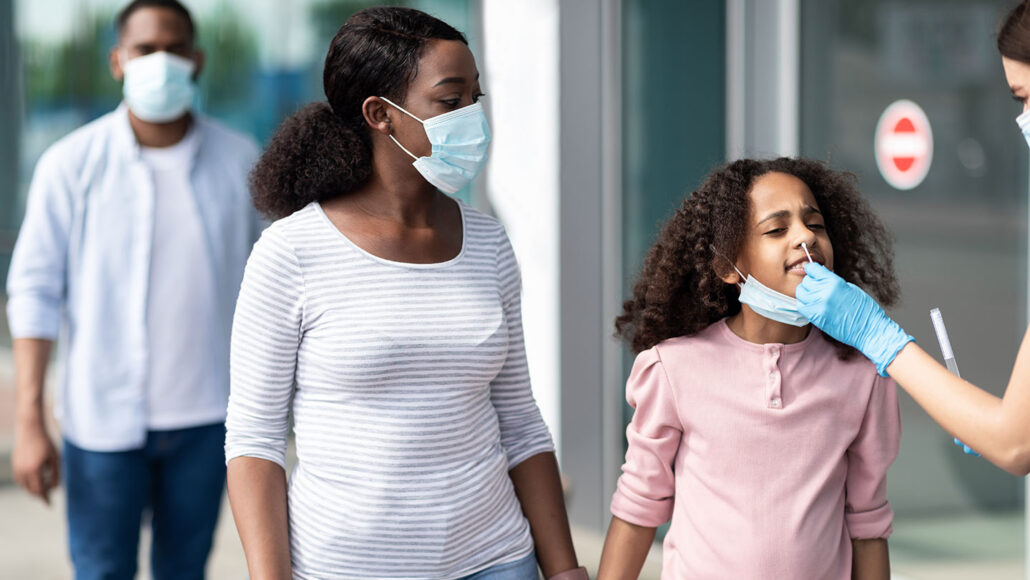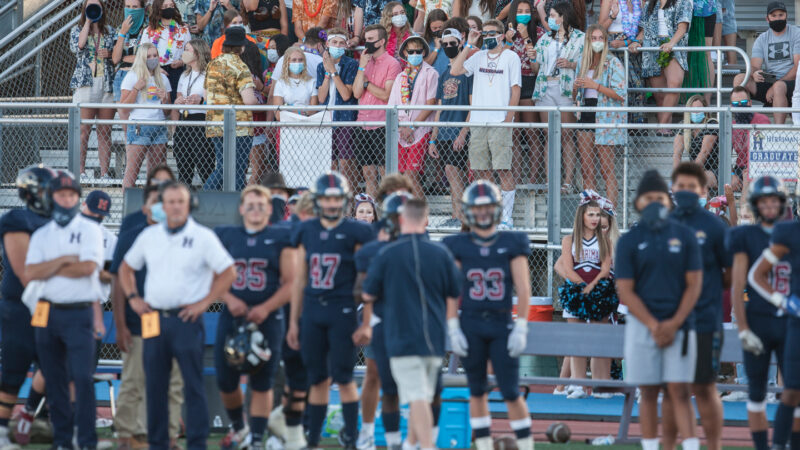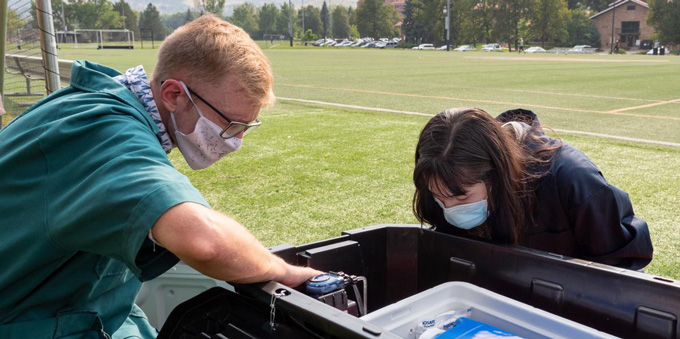How COVID-19 testing plans can keep kids safe in school
Multiple testing strategies exist to support in-person learning

Coronavirus tests, whether done with a saliva sample or a nasal swab, are one tool that schools can use to monitor and prevent COVID-19 outbreaks this year.
Prostock-Studio/iStock/Getty Images Plus
Backpack? Check. Notebooks and pencils? Check. Coronavirus test? Check.
This fall, many kids and teens have left Zoom school behind and returned to the classroom. To keep them safe, the U.S. Centers for Disease Control and Prevention, or CDC, advises that schools employ a range of measures to protect against COVID-19. These include social distancing, masking for all students and teachers and improved filtering of classroom air. The CDC also recommends testing students regularly for the coronavirus.
Testing “is a way we can spend money to reduce [infections] while maintaining in-person school time,” says Alyssa Bilinski. She’s works at Brown University in Providence, R.I. There, she models the spread of infectious diseases. Testing is “a flexible tool.” By that she means it can be increased or decreased based on the need. And, she adds, “It can both stop transmission and provide real-time, school-specific information.” That can help schools decide whether they need to do more.
Some schools had coronavirus outbreaks during the last school year. But in those that had measures in place to minimize disease spread, the rate of transmission was usually equal to or lower than community levels, the CDC says. Now, however, many school districts are under pressure to remove measures like masking or testing. This is despite a nationwide surge in COVID-19 cases driven by the delta variant.
With delta, “testing is going to be even more critical” in schools, says Gigi Gronvall. She’s an immunologist at the Johns Hopkins Center for Health Security. It’s in Baltimore, Md.
In a perfect world, all students could be tested daily with a free test. That test would tell instantly, with 100 percent accuracy, whether someone was infected, Gronvall says. But such tests do not exist. Plus, schools don’t have unlimited money or the ability to create perfect protocols. Instead, districts will need to weigh trade-offs among different types of coronavirus tests. They will have to balance how often they test and whom they test .
Here’s a look at some of the testing strategies that schools are using, along with their benefits and challenges.
When tests are pooled
Last February, the Northborough-Southborough public schools in eastern Massachusetts started a new routine. Once a week, thousands of students (with parental consent) swabbed their noses at home. They stuck the swab in a plastic baggie, then brought it to school. There, swabs were pooled into groups of 16 and shipped off to a nearby lab. Technicians at the lab combined material from these swabs and then performed PCR tests.
PCR stands for polymerase (Puh-LIM-er-ace) chain reaction. These tests can detect bits of genetic material in samples. Here they’re looking for signs of the coronavirus. The tests represent the gold standard for diagnostic tests. A PCR test will almost never say that an uninfected person has the coronavirus. That would be what’s known as a false positive. But PCR tests can miss real infections. It misses them about 10 to 20 percent or more of the time. Still, it’s the most accurate test now in use.
A PCR test is more expensive than less accurate tests. It also takes more time to run. Combining individual samples into pools is one cost-saving measure. If a pooled test is negative, there’s no need to test all those students one at a time. That can save a lot of money.
For pooled testing to work, buy-in from students is crucial. In Northborough-Southborough schools, peak participation rates averaged about 60 percent. When students tested positive, nurses at the school would scramble to call the children. Kids were told to isolate themselves, and identify everyone they had recently been in contact with. Nurses would then call those contacts to warn them they might have been exposed. This practice is known as contact tracing.
But pooled testing has its downsides. Not all schools have easy access to PCR-test labs. It also takes a couple days to get results. Then it takes even more time to do contact tracing. This provides ample opportunity for infected students to spread the virus. This might prove especially worrisome with the delta variant. People can spread it much sooner once they become infected.
Test-to-play, test-to-stay
High school football players were the guinea pigs for Utah’s rapid-testing strategy.
Almost all schools in that state tried to keep in-person classes during the last school year. In the first couple months of school, the state saw “a spike in case counts [among students],” notes Kendra Babitz. She’s the state’s COVID-19 testing director. She works for the Utah Department of Health. That coronavirus spike peaked in November. This prompted schools to call off extracurricular activities. The one exception: football playoffs.
“They were just about done, and we thought this would be a great place to test out testing,” Babitz says.
To compete, athletes had to present a negative test within 72 hours before a game or practice. Players with positive tests were barred from playing and told to isolate for 10 days. Their close contacts were told to quarantine too.

This strategy appears to have pushed players to take other preventive measures, as well, such as wearing masks, Babitz says. The playoffs themselves went off with few hitches. And over two weeks, the share of positive tests dropped from about 4 percent of players to about 2 percent.
Later, 13 high schools in the state adopted a similar protocol for in-person classes. These schools screened all consenting students with rapid antigen tests whenever COVID-19 cases spiked above 1 or 2 percent of the student body.
Those who tested negative could stay in school. Students who tested positive had to isolate at home for 10 days. Students who opted out of the program were recommended, but not required, to switch to remote learning.
Allowing students to test out of remote learning after an outbreak saved more than 100,000 in-person student-learning days. Babitz and others reported this May 28 in Morbidity and Mortality Weekly Report. COVID-19 cases in these schools also fell after the strategy was implemented.
Overall, these programs were “a big success,” Babitz says. In all, nearly 60,000 students were tested through both programs. Nearly 1,900, or 3.2 percent, got a positive result.
Antigen tests work by rapidly detecting proteins from the coronavirus. They’re faster than PCR tests because they don’t rely on the time-consuming sequencing of genetic material. Their quick turnaround offers big advantages over PCR testing. But some experts worry that the rates of false-positive results from the rapid tests in people who show no symptoms could send some students into unnecessary quarantines.
“If you’re using a rapid test for screening, it’s important to have a confirmatory test available — and available quickly,” says Andrea Ciaranello. That way schools can confirm “whether you really need to isolate that person and quarantine their contacts.” Ciaranello is an infectious disease physician at Massachusetts General Hospital in Boston.
Innovative ideas
Last year, Colorado Mesa University in Grand Junction went beyond simply swabbing students’ noses. The school opted to also look at its students’ bodily wastes.
Infected people shed virus into their stool. Once flushed, those feces flow through pipes. These wastes combine with the wastes from other toilets in nearby buildings and even neighborhoods. This slurry can be sampled. Using PCR to test for coronavirus at different stages of the system offers a quick way to effectively screen tens to thousands of people.

The university sampled the wastewater from individual dorms last year. This allowed the school to detect five COVID-19 outbreaks in their early stages. Such screening can provide information on an infection’s spread within a community. It also can guide decisions about whether other protective measures should be scaled up or down.
“Wastewater is ideal for a residential system, where everyone is pooping into the same sewage system,” Ciaranello says. That’s not always the case in a K-12 school setting, she says, since students are only there for a few hours each day.
But there is another place that the coronavirus can accumulate: air filters. David Coil is a microbiologist at the University of California, Davis. He is developing a form of surveillance testing that piggybacks off of the increased use of air filters in some schools.
The coronavirus is an example of an RNA virus. “By testing air filters for viral RNA, we can see whether a virus is circulating in a classroom,” he says. It’s like the testing of pooled samples in that it covers many students in a single sample. And it doesn’t require wrangling consent forms from parents and actual swabs from kids, he adds — at least not until a classroom tests positive.
More creative testing measures like these may be necessary this fall. But there’s now an opportunity to scale up promising approaches, says Bilinski. She’s the infectious-disease modeler at Brown University. “At this stage of the pandemic, we have both the technology and the funding to make exposures less costly and disruptive. We should use it.”
Tina Hesman Saey contributed reporting to this story.







